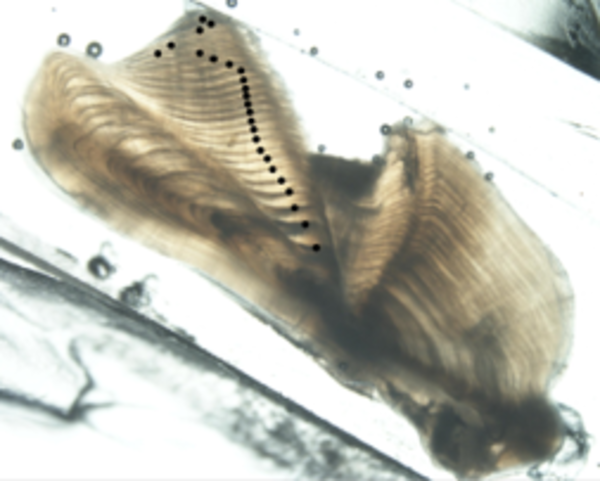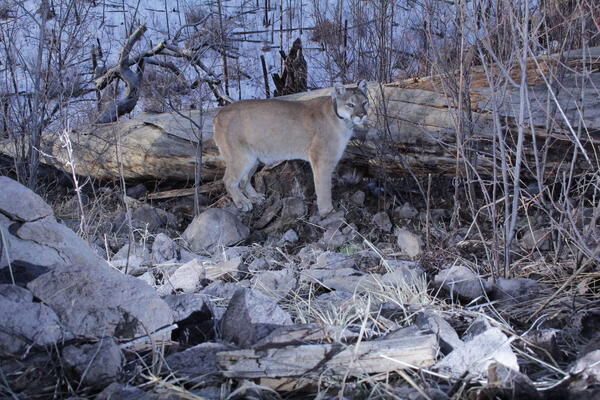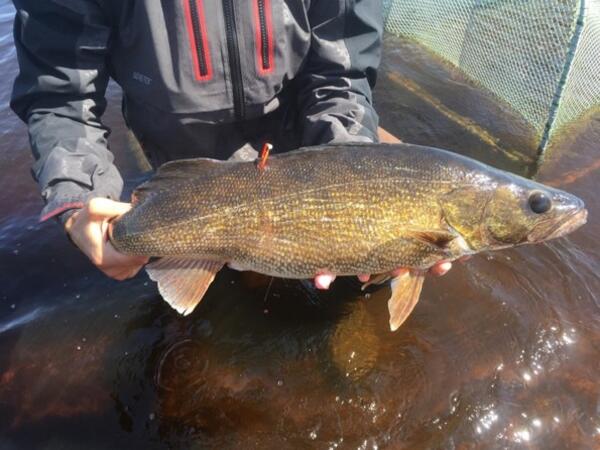American bullfrogs are causing big problems for our native wildlife in Arizona. These non-native frogs are a threat to species like the federally threatened Chiricahua leopard frog and northern Mexican garter snake. Bullfrogs breed quickly and spread far, making it tough to control their numbers. But there’s good news!
Images
We are cultivating and sharing the creativity, vision, and innovative perspectives that can be found among our graduate student, staff, faculty, and friends.
American bullfrogs are causing big problems for our native wildlife in Arizona. These non-native frogs are a threat to species like the federally threatened Chiricahua leopard frog and northern Mexican garter snake. Bullfrogs breed quickly and spread far, making it tough to control their numbers. But there’s good news!

The Wisconsin Department of Natural Resources conducts annual dip net surveys at sturgeon spawning locations throughout the Lake Winnebago system
linkFor nearly a decade, USGS researchers at the Wisconsin Cooperative Fishery Research Unit (WICFRU) have partnered with the Wisconsin Department of Natural Resources to better understand and manage the lake sturgeon population in the Lake Winnebago System.
The Wisconsin Department of Natural Resources conducts annual dip net surveys at sturgeon spawning locations throughout the Lake Winnebago system
linkFor nearly a decade, USGS researchers at the Wisconsin Cooperative Fishery Research Unit (WICFRU) have partnered with the Wisconsin Department of Natural Resources to better understand and manage the lake sturgeon population in the Lake Winnebago System.
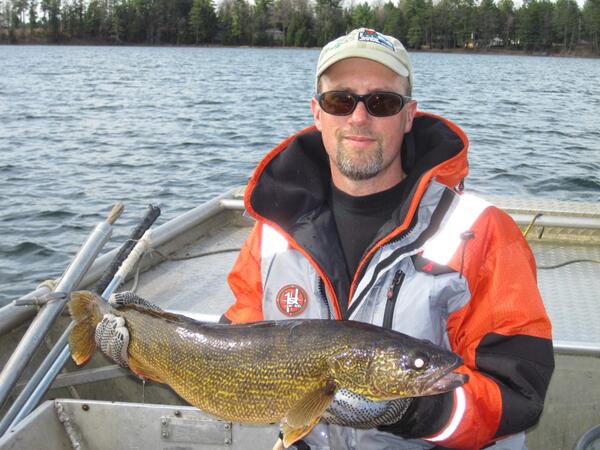
Green Bay, Wisconsin, is home to one of North America's most prominent walleye fisheries, attracting anglers from across the continent and contributing millions of dollars to local economies.
Green Bay, Wisconsin, is home to one of North America's most prominent walleye fisheries, attracting anglers from across the continent and contributing millions of dollars to local economies.
Green Bay supports one of the most prominent walleye fisheries in North America that attracts anglers from across the continent and contributes millions of dollars to local economies.
Green Bay supports one of the most prominent walleye fisheries in North America that attracts anglers from across the continent and contributes millions of dollars to local economies.

Camren Fraser is an M.S. candidate at the Mississippi Cooperative Fish and Wildlife Research Unit
linkCamren Fraser is an M.S. candidate from Boise, ID at the Mississippi Cooperative Fish and Wildlife Research Unit. Camren is researching fish condition through multiple measurements crisscrossing a fish’s body. He was also a finalist in the Image of Research competition sponsored by the Graduate School at Mississippi State University.
Camren Fraser is an M.S. candidate at the Mississippi Cooperative Fish and Wildlife Research Unit
linkCamren Fraser is an M.S. candidate from Boise, ID at the Mississippi Cooperative Fish and Wildlife Research Unit. Camren is researching fish condition through multiple measurements crisscrossing a fish’s body. He was also a finalist in the Image of Research competition sponsored by the Graduate School at Mississippi State University.
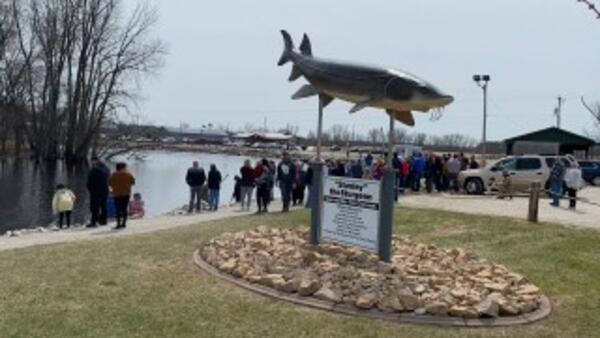
Thousands of people visit lake sturgeon spawning locations on tributaries to Lake Winnebago each year
linkGreen Bay supports one of the most prominent walleye fisheries in North America that attracts anglers from across the continent and contributes millions of dollars to local economies.
Thousands of people visit lake sturgeon spawning locations on tributaries to Lake Winnebago each year
linkGreen Bay supports one of the most prominent walleye fisheries in North America that attracts anglers from across the continent and contributes millions of dollars to local economies.
Habitat change from wildfire and forest restoration treatments can influence habitat conditions for mule deer, elk, mountain lions, and black bears in New Mexico. We are teaming up with our cooperators and partners to design better restoration treatments that reduce wildfires and improve habitat conditions for wildlife.
Habitat change from wildfire and forest restoration treatments can influence habitat conditions for mule deer, elk, mountain lions, and black bears in New Mexico. We are teaming up with our cooperators and partners to design better restoration treatments that reduce wildfires and improve habitat conditions for wildlife.
Habitat change from wildfire and forest restoration treatments can influence habitat conditions for mule deer, elk, mountain lions, and black bears in New Mexico.
Habitat change from wildfire and forest restoration treatments can influence habitat conditions for mule deer, elk, mountain lions, and black bears in New Mexico.
Tagged walleye from the Escanaba River, Michigan. The Wisconsin Cooperative Fishery Research Unit (WICFRU) is working extensively with the Wisconsin and Michigan Departments of Natural Resources to better understand spawning locations and distribution of walleyes in Green Bay.
Tagged walleye from the Escanaba River, Michigan. The Wisconsin Cooperative Fishery Research Unit (WICFRU) is working extensively with the Wisconsin and Michigan Departments of Natural Resources to better understand spawning locations and distribution of walleyes in Green Bay.
Habitat change is putting iconic wildlife such as mule deer, elk, mountain lions, and black bears at risk in the western U.S.
Habitat change is putting iconic wildlife such as mule deer, elk, mountain lions, and black bears at risk in the western U.S.

In Navajo culture, the American black bear holds deep significance, symbolizing strength, protection, and a sacred connection to nature and the spiritual world. Little is known about bear ecology in the area or how they interact with humans.
In Navajo culture, the American black bear holds deep significance, symbolizing strength, protection, and a sacred connection to nature and the spiritual world. Little is known about bear ecology in the area or how they interact with humans.

In Navajo culture, the American black bear holds deep significance, symbolizing strength, protection, and a sacred connection to nature and the spiritual world. Little is known about their ecology or how they interact with humans in Arizona.
In Navajo culture, the American black bear holds deep significance, symbolizing strength, protection, and a sacred connection to nature and the spiritual world. Little is known about their ecology or how they interact with humans in Arizona.

In Navajo culture, the American black bear holds deep significance, symbolizing strength, protection, and a sacred connection to nature and the spiritual world. Little is known about their ecology or how they interact with humans in Arizona.
In Navajo culture, the American black bear holds deep significance, symbolizing strength, protection, and a sacred connection to nature and the spiritual world. Little is known about their ecology or how they interact with humans in Arizona.

Arctic-breeding shorebirds have experienced widespread population declines in recent decades. These declines are occurring even though Arctic nesting grounds are relatively undisturbed by human infrastructure and fragmentation, although future infrastructure expansion poses a threat to breeding birds.
Arctic-breeding shorebirds have experienced widespread population declines in recent decades. These declines are occurring even though Arctic nesting grounds are relatively undisturbed by human infrastructure and fragmentation, although future infrastructure expansion poses a threat to breeding birds.
Arctic-breeding shorebirds have experienced widespread population declines in recent decades. These declines are occurring even though Arctic nesting grounds are relatively undisturbed by human infrastructure and fragmentation, although future infrastructure expansion poses a threat to breeding birds.
Arctic-breeding shorebirds have experienced widespread population declines in recent decades. These declines are occurring even though Arctic nesting grounds are relatively undisturbed by human infrastructure and fragmentation, although future infrastructure expansion poses a threat to breeding birds.

Researcher attaches a bird band to track the movement patterns of dunlin shorebirds in northern Alaska
linkAaron Yappert is a master’s student at Iowa State University in the USGS Iowa Cooperative Fish and Wildlife Research Unit. His research focuses on the movement ecology of Dunlin, a medium-sized shorebird, on the breeding grounds in northern Alaska.
Researcher attaches a bird band to track the movement patterns of dunlin shorebirds in northern Alaska
linkAaron Yappert is a master’s student at Iowa State University in the USGS Iowa Cooperative Fish and Wildlife Research Unit. His research focuses on the movement ecology of Dunlin, a medium-sized shorebird, on the breeding grounds in northern Alaska.

Researchers use high frequency GPS tracking devices to monitor movements of dunlin shorebirds in northern Alaska
linkArctic-breeding shorebirds have experienced widespread population declines in recent decades. These declines are occurring even though Arctic nesting grounds are relatively undisturbed by human infrastructure and fragmentation, although future infrastructure expansion poses a threat to breeding birds.
Researchers use high frequency GPS tracking devices to monitor movements of dunlin shorebirds in northern Alaska
linkArctic-breeding shorebirds have experienced widespread population declines in recent decades. These declines are occurring even though Arctic nesting grounds are relatively undisturbed by human infrastructure and fragmentation, although future infrastructure expansion poses a threat to breeding birds.
Arctic-breeding shorebirds have experienced widespread population declines in recent decades. These declines are occurring even though Arctic nesting grounds are relatively undisturbed by human infrastructure and fragmentation, although future infrastructure expansion poses a threat to breeding birds.
Arctic-breeding shorebirds have experienced widespread population declines in recent decades. These declines are occurring even though Arctic nesting grounds are relatively undisturbed by human infrastructure and fragmentation, although future infrastructure expansion poses a threat to breeding birds.

In January 2025, Sammy accepted the CRU Regional Unit Supervisor for the Northeast Region. Unit scientists and unit supervisors work with cooperators to help them identify their needs, and unit
supervisors ensure that all research conducted is aligned with the USGS mission.
In January 2025, Sammy accepted the CRU Regional Unit Supervisor for the Northeast Region. Unit scientists and unit supervisors work with cooperators to help them identify their needs, and unit
supervisors ensure that all research conducted is aligned with the USGS mission.

Margot Breiner, MS student, using telemetry to re-locate a boreal toad. Boreal toads, once common in the Rocky Mountain region, have experienced significant population declines. These declines are linked to habitat loss and infection by the fungal pathogen Batrachochytrium dendrobatidis.
Margot Breiner, MS student, using telemetry to re-locate a boreal toad. Boreal toads, once common in the Rocky Mountain region, have experienced significant population declines. These declines are linked to habitat loss and infection by the fungal pathogen Batrachochytrium dendrobatidis.
Boreal toads, once common in the Rocky Mountain Region have experienced significant population declines. These declines are linked to habitat loss and infection by the fungal pathogen Batrachochytrium dendrobatidis. This boreal toad pictured is from the La Barge Creek watershed in Wyoming.
Boreal toads, once common in the Rocky Mountain Region have experienced significant population declines. These declines are linked to habitat loss and infection by the fungal pathogen Batrachochytrium dendrobatidis. This boreal toad pictured is from the La Barge Creek watershed in Wyoming.



